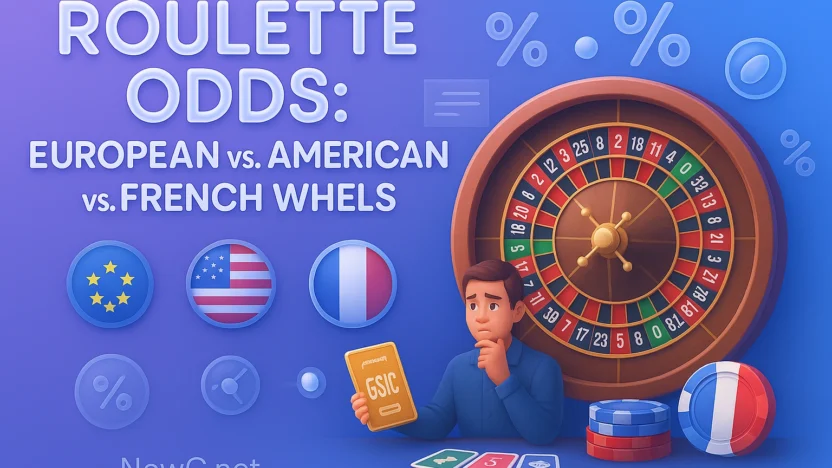Last Updated on November 19, 2025 by Caesar Fikson
Roulette looks simple, but the odds shift a lot depending on the wheel you choose and the rules the pit quietly posts on the placard. If you understand how the pockets, payouts, and special rules interact, you stop donating edge by accident and start buying the best version of the same game.
I’ll walk you through European, American, and French wheels the way I explain it to operators and floor teams. You’ll get clear tables, real hit rates, the truth about la partage/en prison, and why the infamous American five-number bet is a margin machine.
When I say “we,” I mean we at NOWG; when I say “you,” I’m talking to you as the operator or serious player making choices that actually move EV.
Wheel anatomy and baseline house edge
European and French wheels have 37 pockets (0–36). American wheels add 00 for 38 pockets. Same 35:1 payout on a straight-up hit, but different true odds → different house edge.
Wheel comparison at a glance
| Wheel type | Pockets | Zeros | Even-money rule on 0 | House edge (most bets) | Even-money house edge |
|---|---|---|---|---|---|
| European (single-zero) | 37 | 0 | Lose full stake | 2.70% | 2.70% |
| French (single-zero with la partage / en prison) | 37 | 0 | Lose half (la partage) or hold (en prison) on 0 | 2.70% (non even-money) | 1.35% |
| American (double-zero) | 38 | 0 & 00 | Lose full stake | 5.26% (all but one bet) | 5.26% |
| American with “surrender” (rare) | 38 | 0 & 00 | Lose half on 0/00 (even-money only) | 5.26% (non even-money) | ≈2.63% |
My take: If you can’t get French rules, European single-zero is your baseline. American doubles your long-run cost for the same spectacle; surrender is a decent band-aid when it exists.
Payouts, probabilities, and edge by bet
Roulette’s genius is the illusion of variety. Change the shape of your bet and the hit rate changes, but unless a special rule kicks in, the house edge stays constant per wheel—except for one notorious American wager.
Core bet math per spin (side-by-side)
| Bet type | Numbers covered | Payout | Hit rate EU (37) | Hit rate US (38) | House edge EU | House edge US | Notes |
|---|---|---|---|---|---|---|---|
| Straight up | 1 | 35:1 | 1/37 = 2.70% | 1/38 = 2.63% | 2.70% | 5.26% | “Lucky number” |
| Split | 2 | 17:1 | 2/37 = 5.41% | 2/38 = 5.26% | 2.70% | 5.26% | Edge unchanged |
| Street (row of 3) | 3 | 11:1 | 8.11% | 7.89% | 2.70% | 5.26% | |
| Corner (4) | 4 | 8:1 | 10.81% | 10.53% | 2.70% | 5.26% | |
| Six line (6) | 6 | 5:1 | 16.22% | 15.79% | 2.70% | 5.26% | |
| Dozen / Column (12) | 12 | 2:1 | 32.43% | 31.58% | 2.70% | 5.26% | |
| Even-money (18) | 18 | 1:1 | 48.65% | 47.37% | 2.70% | 5.26% | Red/Black, Odd/Even, 1–18/19–36 |
| American five-number | 5 | 6:1 | — | 13.16% | — | 7.89% | 0-00-1-2-3 only; avoid |
Why the five-number trap is nasty: true odds 5/38, fair payout 7.6:1, actual payout 6:1 → edge leaps to 7.89%. I tell players and operators the same thing: this bet exists to make accountants smile.
French rules that actually change EV
French tables are still single-zero; the difference is what happens when the ball lands on 0 and you’ve made an even-money bet.
La partage vs en prison (and their math)
| Rule | What happens on 0 (even-money bets only) | Practical effect | House edge (even-money) |
|---|---|---|---|
| La partage | You lose half your stake immediately | Softer landing on 0 | ~1.35% |
| En prison | Your stake is “imprisoned” for the next spin. If your bet would win on that spin, you get it back; otherwise it’s lost | Same long-run EV as la partage | ~1.35% |
Mechanically different, mathematically equivalent. Either way, you halve the penalty of the green zero on even-money bets. Everything else on the layout stays at 2.70% edge.
Operator lens: en prison demands more dealer discipline and player comprehension; la partage is simpler and faster. I prefer partage when training new floors.
Hit frequency, session feel, and volatility
Higher coverage → more frequent small wins → lower variance. You can’t change edge per wheel (aside from rules), but you can choose variance that matches your bankroll and goals.
“How it feels” by bet type (European wheel)
| Bet | Coverage | Approx. hit rate | Session feel | Volatility hint |
|---|---|---|---|---|
| Even-money | 18/37 | 48.65% | Lots of small swings | Low |
| Dozen / Column | 12/37 | 32.43% | Win ~1 in 3 | Low-medium |
| Six line | 6/37 | 16.22% | Win ~1 in 6 | Medium |
| Corner | 4/37 | 10.81% | Win ~1 in 9 | Medium-high |
| Street | 3/37 | 8.11% | Win ~1 in 12 | High |
| Split | 2/37 | 5.41% | Win ~1 in 18 | High |
| Straight up | 1/37 | 2.70% | Long droughts, big hits | Very high |
My opinion: most players overestimate their tolerance for droughts. If you want table time and a shot at a moment, blend one or two straight-ups with a backbone of dozens or even-money.
French racetrack and announced bets (what they are, not superstition)
French layouts add the racetrack and “call” (announced) bets that map to real wheel geometry. Payouts are standard; you’re just covering specific clusters.
Common call bets on a single-zero wheel
| Call bet | Coverage (pockets) | Chip pattern (typical) | What you’re really doing |
|---|---|---|---|
| Voisins du Zéro | 17 numbers (22→25 around 0) | 9 chips: mix of splits/corners | Hug the zero side of the wheel |
| Tiers du Cylindre | 12 numbers (27→33 opposite 0) | 6 chips: five splits + one extra | Cover the “third” opposite zero |
| Orphelins | 8 numbers (two gaps) | 5 chips: four splits + one straight | Fill the leftovers between voisins/tiers |
| Jeu Zéro | 7 numbers near 0 | 4 chips: three splits + one straight | Super-tight near zero |
These sets don’t change edge; they change texture and narrative. On a proper French wheel they feel intuitive because you’re following the physical arc, not just a grid.
Table procedures that matter more than lucky charms
Ball deceleration is chaotic in modern wheels; tight tolerances, ball material, frets, and dealer spin variability make reliable wheel bias rare. I’ve reviewed bias claims for operators—99% are noise once you collect enough spins. “Dealer signature” (predicting sectors from a dealer’s rhythm) pops up on forums; in a real pit with surveillance and mixed spins, it’s wishcasting.
RNG vs live dealer roulette. RNG uses audited PRNGs with single-zero/double-zero probabilities baked in; no memory, no heat. Live dealer uses physical wheels with studio procedures; the math is the same as the floor. If you’re an operator, fairness is product: keep equipment serviced, publish rules clearly, and train dealers on en prison/partage rigorously.
Practical decision framework (how I pick a table or configure a pit)
If I’m playing:
- Scan placards: single-zero? la partage or en prison on even-money? Great. If not, European > American, always.
- If forced onto American: avoid the five-number bet; if surrender exists, lean even-money more.
- Choose variance: want time-on-device? Dozens/columns + light even-money. Want sweat? Layer a couple of straight-ups on top of a low-variance backbone.
If I’m running the room:
• Offer at least one French wheel in visible placement; market the 1.35% even-money edge honestly—players notice the value and return.
• Standardize dealer calls and layouts; racetrack competency reduces mispays and speeds up hands.
• Never hide American five-number math; informed players respect transparency, whales don’t care, and compliance will thank you.
Edge tweaks most people miss
Even-money on French rules is mathematically kinder than dozens/columns in the long run (1.35% vs 2.70%). If your players love even-money rhythm, a French wheel quietly halves their burn rate. On American tables with surrender, even-money bets cut their edge in half relative to the rest of the layout—one of the few times mixing bet types actually changes expectation.
Bankroll guidance that respects variance
Roulette doesn’t reward systems, it rewards discipline. Size your unit to 1–2% of your session bankroll if you’re mixing higher-variance bets; you can go a bit larger if you’re sticking to even-money or dozens and you have la partage working for you. Lock session loss and time limits. If you hit a meaningful win target on a high-variance mix, clip some profit and scale units back; variance giveth and taketh.
American layout quirks worth knowing
American number sequence differs from European; 0 and 00 sit opposite each other, and chip handling includes the five-number box (0-00-1-2-3). You’ll also see more table variants offering “surrender” on even-money. Edge stays 5.26% across the grid except the five-number outlier; that’s the only bet with a worse deal baked into the felt.
Frequently asked roulette questions from serious players
Do betting progressions (Martingale, Labouchere, Fibonacci) change edge?
No. They change variance and bankruptcy risk. On even-money bets with la partage, progressions hurt less when a 0 hits, but the expected loss per spin is still the posted edge.
Does “en prison” help on other bets?
No. It’s an even-money mechanic only. Dozens, columns, and inside bets settle normally on 0.
Are two-zero American wheels ever worth it?
From a pure EV standpoint, no—unless the game offers surrender and the room forbids single-zero. If you’re choosing for entertainment, that’s your call; just price in the extra 2.56 percentage points of edge.
Is wheel bias real in 2025?
Extremely rare on maintained equipment. If you think you’ve found it, collect thousands of spins with time-stamped dealer data, control for ball swaps and wheel maintenance, and prepare for the casino to rotate dealers and wheels. For operators, preventative maintenance and rotation policies are your best defense.
Operator cheat sheet (configure, price, and message)
| Decision | Recommendation | Why it works |
|---|---|---|
| Mix of wheels | At least one French, one European, one American | Segment by value and novelty |
| Signage | Spell out la partage/en prison simply | Reduces disputes, increases adoption |
| Training | Drill racetrack calls and en prison procedures | Speed + accuracy = better experience |
| Marketing | Lead with “half back on zero” for French | Honest value resonates with regulars |
| Analytics | Track bet mix and hold by rule set | See how rules shift session length and NGR |
Here’s my bottom line: roulette is one game with three very different economic experiences. Single-zero cuts your cost, French rules halve it again on the bets players love most, and American doubles it while dangling a five-number trap. Choose (or offer) the version that matches your goals, and be deliberate about variance. The ball does what it does; your edge comes from picking the right table and the right rules before it spins.
If you want a one-pager of these tables for your floor staff or app, I can tailor it to your markets. And if you’re calibrating product mix, promos, or risk, try NOWG’s free online tools for casinos—bonus liability estimators, churn predictors, and CAC→LTV simulators—so you can validate decisions before you deploy them.




